- Wondering how to get Monopoly GO! free rolls? Well, you’ve come to the right place. In this guide, we provide you with a bunch of tips and tricks to get some free rolls for the hit new mobile game. We’ll …
Best Roblox Horror Games to Play Right Now – Updated Weekly
By Adele Wilson
Our Best Roblox Horror Games guide features the scariest and most creative experiences to play right now on the platform!The BEST Roblox Games of The Week – Games You Need To Play!
By Sho Roberts
Our feature shares our pick for the Best Roblox Games of the week! With our feature, we guarantee you'll find something new to play!Type Soul Clan Rarity Guide – All Legendary And Common Clans Listed!
By Nathan Ball
Wondering what your odds of rolling a particular Clan are? Wonder no more, with my handy Type Soul Clan Rarity guide.
Call of Cthulhu: The Wasted Land, Developer Diary #2
Hello again, fellow Gamezebo readers. I’m Tomas Rawlings, the designer of the new upcoming Call of Cthulhu: The Wasted Land, a role-playing/strategy game set in the midst of World War I. It’s based on the classic, multi-award winning paper role playing game of the same name, which coincidently this year celebrated its 30th anniversary.
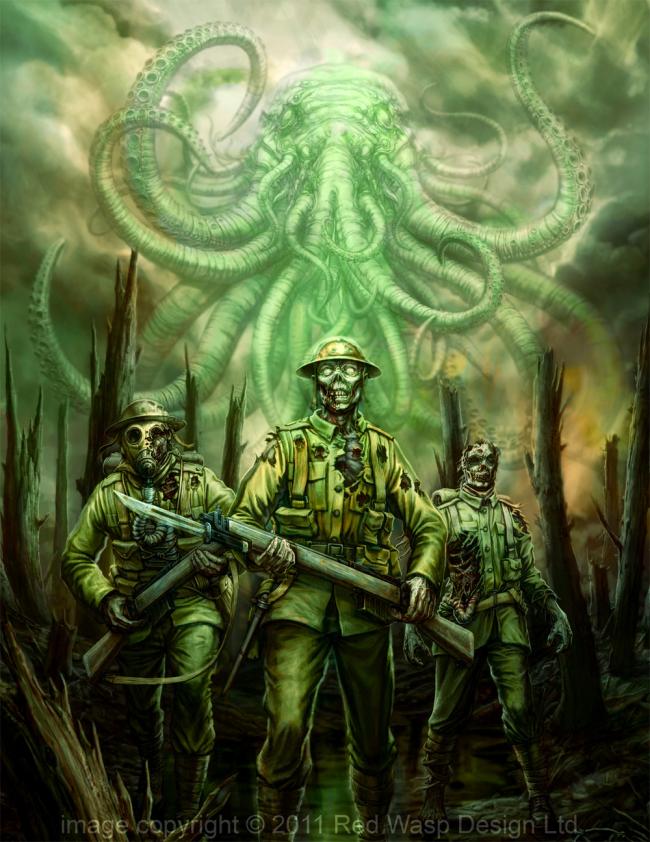
Hello again, fellow Gamezebo readers. I’m Tomas Rawlings, the designer of the new upcoming Call of Cthulhu: The Wasted Land, a role-playing/strategy game set in the midst of World War I. It’s based on the classic, multi-award winning paper role playing game of the same name, which coincidently this year celebrated its 30th anniversary.
In our first developer diary, I talked about the history of the project and about some of the design challenges we’ve had in adapting the game to mobile. This time I want to talk about the art of the game. If you’ve been following our progress then you might have seen this image that our lead artist, Stuart Griffin, produced for the press launch:

This is a 2D image made using fairly traditional art methods (more of how the image was made here) and it’s a great image for both showing the project to the public (before we’d made any real in-game art) and also giving all of us working on the game a visual image that guides us.
However in the day-to-day business of game creation, the art is constructed very differently. Firstly it’s all 3D; now the 2D/3D in games can get confusing because you can get games that are built in 3D that play like a 2D game and games that look 2D but are actually 3D. For us as developers, 3D means it takes more resources to make an initial model or character, but once created we can do much more with it.
The first stage of creating a 3D image is to use a 3D design tool to build the item, character or object in question. Lets take the example of a Dark Young, these are the monstrous living-tree beasts who are the foul offspring of their mother-deity, Shub-Niggurath. Now their creators describes them as thus; “…it was the black thing of my dreams – that black ropy, slimy jelly tree-thing out of the woods.” (from Robert Bloch’s ‘Notebook Found in a Deserted House’)
Stuart starts by creating a really high resolution model for the Dark Young. With such tools (you can try the free and open source Blender if you want to try 3D creation yourself!) we create a 3-dimensional model of the object, like a virtual sculpture. In graphics terms, the more complex the model, the better it looks, but the more processing time it takes to display it and move it around on the screen. This is why a Pixar film will always look better than a PS3 game – because they are not generating the film in real time. They can take weeks if need be, to generate a few minutes of footage whereas a game is real-time.
Because the player can be anywhere in the level, the graphics have to be calculated on-the-fly continuously. That means in-game we’re always looking to keep the complexity of the model down while trying to keep it looking good. Here’s our high quality (or high poly, as in ‘polygon’, as we call it) version:
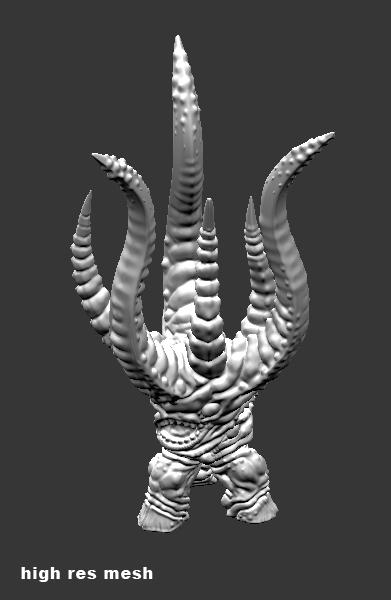
In 3D game graphics we make a 3D object then wrap a 2D picture over it; like wallpapering a statue. These images are made in an art package such as Photoshop or GIMP (again, try the open source GIMP if you want have a play with such a tool). The image, or texture map as it’s generally known, looks odd because, like a map of the world, it’s effectively the surface of a 3D object unwrapped into a 2D form. We occasionally use more of the texture’s space for features like faces or hands than we do on areas like legs, so the end result looks more detailed. This is how the one for the Dark Young looks:
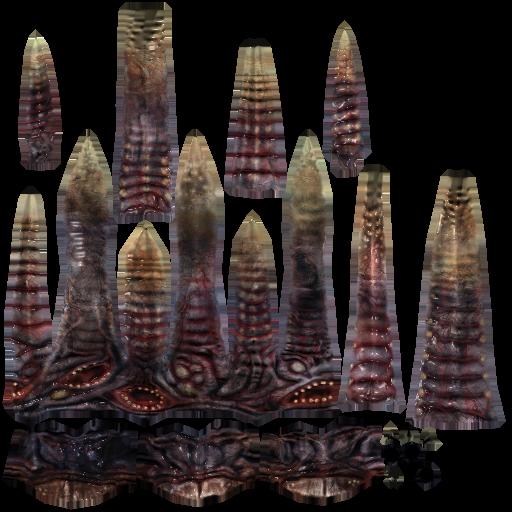
Then this is how it looks wrapped to the 3D model:
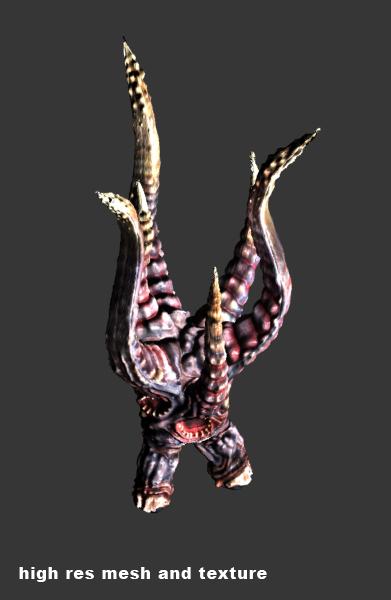
From this, Stuart generates a new, far lower resolution mesh and texture map. The revised one looks like this:
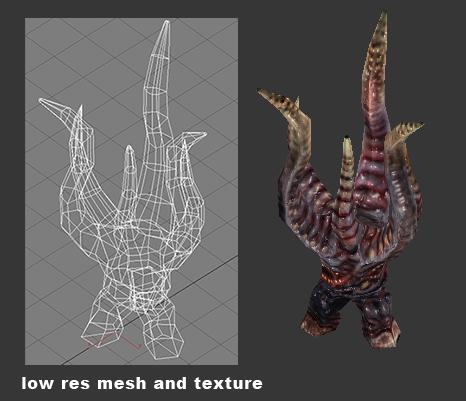
Even though this approach (generating a low resolution model from a higher resolution version) is generally slower than just building a low resolution model from scratch, it has a couple of big advantages: firstly, we can use the higher resolution models for generating things such as character portraits. Secondly, if we decide to port the game onto other systems, we can generate new meshes with the appropriate level of detail relatively quickly rather than rebuilding everything again. Our landscapes are generated in much the same way.
Now Stuart can look to build the animations and effects for that monster, then do it all over again for the other monsters and the game’s characters. Interestingly, humans tend to be harder work than monsters, because our understanding of how a human looks and moves is so much higher because we see that every day, but how often have you seen a Dark Young strolling about?
That’s all for now. Next time we’ll be taking a closer look at the technology side of the game and how all these models and meshes get combined to make an actual game. You can also follow Red Wasp Design on Facebook or Twitter and also on our blog. Thanks!
More articles...
Monopoly GO! Free Rolls – Links For Free Dice
By Glen Fox
Wondering how to get Monopoly GO! free rolls? Well, you’ve come to the right place. In this guide, we provide you with a bunch of tips and tricks to get some free rolls for the hit new mobile game. We’ll …Best Roblox Horror Games to Play Right Now – Updated Weekly
By Adele Wilson
Our Best Roblox Horror Games guide features the scariest and most creative experiences to play right now on the platform!The BEST Roblox Games of The Week – Games You Need To Play!
By Sho Roberts
Our feature shares our pick for the Best Roblox Games of the week! With our feature, we guarantee you'll find something new to play!Type Soul Clan Rarity Guide – All Legendary And Common Clans Listed!
By Nathan Ball
Wondering what your odds of rolling a particular Clan are? Wonder no more, with my handy Type Soul Clan Rarity guide.







